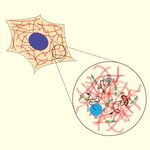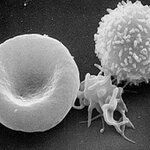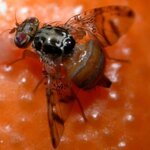Genetics & Molecular Biology

An enzyme called 12-LO promotes obesity-induced oxidative stress in the pancreatic cells and that has been linked to diabetes (and pre-diabetes, if you prefer made-up conditions mainstream science wishes studies would stop claiming to be about).
12-LO's enzymatic action is the last step in the production of certain small molecules that harm the cell, according to a team from Indiana University School of Medicine. The findings will enable the development of drugs that can interfere with this enzyme, preventing or even reversing diabetes.
Over 25 million Americans have diabetes but…

The cytoplasm of mammalian cells is a viscous fluid, with organelles and proteins jiggling against one another and drifting at random.
Yet a new biophysical study finds that those drifting objects are subject to a very different type of environment than what we have thought.
The cytoplasm is actually an elastic gel, it turns out, so it puts up some resistance to simple diffusion. But energetic processes elsewhere in the cell—in the cytoskeleton, especially—create random but powerful waves in the cytoplasm, pushing on proteins and organelles alike. Like flotsam and jetsam buffeted by the…

Hematopoietic stem cells (HSCs) are adult stem cells isolated from blood or bone marrow that can renew themselves and differentiate into a variety of specialized cells. They give rise to all other blood cell types but their development has long remained a mystery.
In a new paper, researchers elaborate upon a crucial signaling pathway and the role of key proteins, which may help clear the way to generate HSCs from human pluripotent precursors, similar to advances with other kinds of tissue stem cells.
Principal investigator David Traver, PhD, professorat U.C. San Diego School of…

Scientists have identified a gene, Lhx1, that regulates sleep and wake rhythms.
The discovery of the role Lhx1 provides scientists with a potential therapeutic target to help night-shift workers or jet lagged travelers adjust to time differences more quickly. T
Every cell in the body has a "clock" – an abundance of proteins that dip or rise rhythmically over approximately 24 hours. The master clock responsible for establishing these cyclic circadian rhythms and keeping all the body's cells in sync is the suprachiasmatic nucleus (SCN), a small, densely packed region of about 20,000 neurons…

Not that you want to do this but there is an easy way to speed up a woman's reproductive timing - just get a clock.
Not one of those modern digital things, an actual ticking clock will literally do it, says a paper upcoming in Human Nature.
It turns out that the tick-tock of the metaphor has some basis in reality. Or not. The authors also claim that poor women are more likely to be affected by this ticking sound. And the authors are psychologists so beware of mainstream media making grand biological claims based on this.
Psychology graduate student Justin Moss and Professor Jon Maner of…

Researchers have create a molecule that can cause cancer cells to self-destruct by carrying sodium and chloride ions into the cells.
Synthetic ion transporters have been created before, but this is the first time researchers have demonstrated how an influx of salt into a cell triggers cell death. These synthetic ion transporters could point the way to new anticancer drugs while also benefiting patients with cystic fibrosis.
Study co-author Professor Philip Gale, of the University of Southampton, says, "This work shows how chloride transporters can work with sodium channels in cell membranes…

The Mediterranean fruit fly is a serious agricultural pest, it
infests more than 300 types of cultivated and wild fruits, vegetables and nuts and causes extreme damage to crops all around the world.
The fly is currently controlled by a combination of insecticides, baited traps, biological control and releasing sterilized insects to produce non-viable matings, known as the Sterile Insect Technique (SIT).
The Mediterranean fruit fly is a serious agricultural pest which causes extensive damage to crops.
Releasing genetically engineered fruit flies into the wild could prove to…

Scientists have sequenced the genome of Belgica antarctica, the Antarctic midge – the smallest in insects described to-date – and believe it can explained by the midge's adaptation to its deep-freeze extreme living environment.
The midge is a small, wingless fly that spends most of its two-year larval stage frozen in the Antarctic ice. Upon adulthood, the insects spend seven to 10 days mating and laying eggs, and then they die. Its genome contains only 99 million base pairs of nucleotides, making it smaller than other tiny reported genomes for the body louse (105 million base pairs) and…

Researchers have come up with a promising method of treating male infertility; a synthetic version of the sperm-originated protein known as PAWP. PAWP has been shown to be required, they write, and their synthetic version was sufficient to initiate the fertilization process.
According to the Centers for Disease Control and Prevention's 2013 Annual Report on Assisted Reproductive Technologies, only about 37 percent of treatment cycles lead to successful pregnancy. This low success rate may be due to a variety of factors in the male and female including the inability of sperm cell to initiate…

Hey, heads up Public: game-changing new science means we can probably make insects stop spreading malaria, dengue fever, and Lyme disease. Or reverse pesticide resistance in agricultural pests. Or even eliminate invasive (or otherwise undesired) species. But this has major public policy implications, and scientists want to make sure everybody knows what we’re getting into and we set up safeguards before any of this actually happens.
Population-level engineering could make mosquitoes resistant to malaria, preventing them from spreading it and maybe even eradicating the…